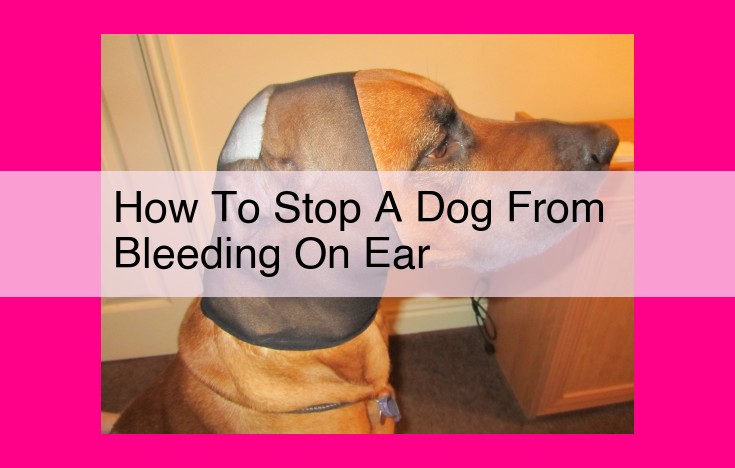Stop Dog Ear Bleeding: Step-By-Step Guide, Prevention Tips, And Treatment Options

To stop a dog’s ear from bleeding, apply direct pressure to the wound using a clean towel or gauze. Elevate the dog’s head to reduce blood flow to the area. If bleeding persists, seek veterinary attention for further evaluation and treatment options, which may include surgery, antibiotics, or hemostatic agents. Regular ear cleaning, earplugs during water activities, and veterinary checkups can help prevent ear bleeding.
Medical Conditions Affecting Dog Ears: Understanding Ear Bleeding
Dog ears are delicate and prone to various medical conditions that can cause discomfort and bleeding. Understanding these conditions is crucial for responsible dog owners, as early detection and treatment can prevent further complications.
Ear Hematoma
An ear hematoma occurs when blood accumulates within the ear flap, forming a blood-filled swelling. This condition typically results from trauma or injury to the ear, causing blood vessels to rupture and leak into the surrounding tissue. Ear hematomas are often painful and can interfere with the dog’s hearing.
Otitis Externa
Otitis externa, commonly known as an ear infection, is an inflammation of the outer ear canal. Bacteria or yeast can cause this infection, resulting in redness, swelling, and discharge. If left untreated, otitis externa can spread and cause further complications.
Aural Polyp
An aural polyp is a non-cancerous growth that develops in the ear canal. These growths can vary in size and shape, and they can block the ear canal, leading to hearing problems and discomfort. Aural polyps often require surgical removal to restore hearing and prevent further complications.
Cut or Laceration
Dogs can suffer from cuts or lacerations on their ears from injuries such as fights, falls, or bites. These wounds can be superficial or deep, and they may bleed profusely if not treated promptly.
Treatment Options for Dog Ear Bleeding
When faced with the unsettling sight of your furry friend’s ear bleeding, prompt action is crucial. Understanding the various treatment options available can empower you to make informed decisions and ensure your dog’s well-being.
1. Consulting a Veterinarian: The First Step
The initial step towards treating dog ear bleeding is seeking professional veterinary guidance. An experienced veterinarian will assess your dog’s ear thoroughly, identify the underlying cause, and recommend appropriate treatments. They may perform an otoscopic examination, where a specialized instrument is used to visualize the ear canal and diagnose any abnormalities.
2. Surgery: When Repair or Drainage is Needed
In cases of severe ear bleeding due to damaged blood vessels or excessive fluid buildup, surgical intervention may be necessary. Surgical procedures can involve repairing the affected blood vessels, draining the accumulated fluid, or removing non-cancerous growths (aural polyps).
3. Antibiotics: Combating Bacterial Infections
Ear bleeding can sometimes result from bacterial infections within the ear canal. In such cases, antibiotics prescribed by your veterinarian will help eliminate the infection and prevent further complications. These medications effectively target and kill bacteria, reducing inflammation and promoting healing.
4. Hemostatic Agents: Stopping the Bleeding
When ear bleeding occurs due to a cut or laceration, hemostatic agents are often used to stop the bleeding quickly. These agents, available in powder or liquid form, form a protective layer over the wound, facilitating clotting and reducing blood loss.
Preventing Ear Bleeding in Dogs
- Regular ear cleaning to remove dirt and debris
- Using earplugs during water activities to prevent moisture buildup
- Scheduling regular veterinary checkups for early detection and treatment of ear problems
Preventing Ear Bleeding in Dogs
Ear bleeding in dogs can be a distressful sight, but it’s crucial to know that prevention is key to keeping your furry friend’s ears healthy and blood-free. Here are a few essential ways to protect your dog’s ears:
Regular Ear Cleaning
Just like brushing your teeth, regular ear cleaning is vital for maintaining ear hygiene. Dirt, debris, and bacteria can easily accumulate in a dog’s ear canals, leading to irritation and infection. By cleaning their ears, you’re removing these potential hazards and reducing the risk of ear bleeding.
Ear Protection During Water Activities
Dogs love to swim and splash, but moisture buildup in the ears can foster ear infections, which can progress to bleeding. Protect your dog’s ears during water activities by using earplugs specifically designed for dogs. These plugs effectively keep water out of the ear canals, preventing ear infections and their associated risks.
Veterinary Checkups
Regular veterinary checkups are not just for vaccinations. Professional ear examinations allow your veterinarian to detect any early signs of ear problems, such as inflammation, infection, or growths, before they progress to more severe conditions that could lead to bleeding.
Remember, ear bleeding can often be a symptom of underlying medical conditions, such as allergies, parasites, or systemic diseases. By taking proactive steps to prevent ear problems, you’re not only safeguarding your dog’s ears but also contributing to their overall health and well-being.
Additional Considerations Regarding Dog Ear Bleeding
When it comes to dog ear bleeding, certain factors need to be taken into account:
1. Sensitivity Based on Breed and Ear Anatomy:
Dog breeds with floppy ears, such as Cocker Spaniels and Beagles, are more susceptible to ear bleeding due to increased moisture retention in their ear canals. Similarly, dogs with droopy ears or excessive ear hair can experience increased risk.
2. Ear Bleeding as an Indicator of Underlying Issues:
Ear bleeding may not always originate from ear-related causes. It can also signal underlying health conditions, such as allergies, immune disorders, or systemic infections. In such cases, prompt veterinary attention is vital to ensure proper diagnosis and treatment.
3. Importance of Proper Ear Care:
Regular ear cleaning is paramount in preventing dog ear infections and bleeding. Removing debris and excess moisture helps maintain ear health. Additionally, earplugs are recommended during water activities to prevent moisture buildup.
Routine veterinary checkups provide opportunities for professional ear examinations and early detection of potential issues. By addressing ear problems promptly, you can effectively safeguard your dog’s ear health and prevent unnecessary bleeding.